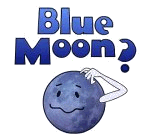 Tomorrow night, when the full moon rises over North America, it will be a “blue moon,” the first such occurrence to fall on December 31st since 1990.
Tomorrow night, when the full moon rises over North America, it will be a “blue moon,” the first such occurrence to fall on December 31st since 1990.
The modern definition for “blue moon” is the second full moon to occur within a calendar month and tomorrow’s full moon will indeed be the second to occur in the month of December, 2009.
Cartoon Image courtesy of NASA.
But wait – there’s more to the blue moon phenomenon . . .
From NASA
Most months have only one full Moon. The 29.5-day cadence of the lunar cycle matches up almost perfectly with the 28- to 31-day length of calendar months. Indeed, the word “month” comes from “Moon.” Occasionally, however, the one-to-one correspondence breaks down when two full Moons squeeze into a single month. Dec. 2009 is such a month. The first full Moon appeared on Dec. 2nd; the second, a “Blue Moon,” will come on Dec. 31st.
This definition of Blue Moon is relatively new.
. . .
The modern definition sprang up in the 1940s. In those days, the Farmer’s Almanac of Maine offered a definition of Blue Moon so convoluted that even professional astronomers struggled to understand it. It involved factors such as the ecclesiastical dates of Easter and Lent, and the timing of seasons according to the dynamical mean sun. Aiming to explain blue moons to the layman, Sky & Telescope published an article in 1946 entitled “Once in a Blue Moon.” The author James Hugh Pruett cited the 1937 Maine almanac and opined that the “second [full moon] in a month, so I interpret it, is called Blue Moon.”
That was not correct, but at least it could be understood. And thus the modern Blue Moon was born.
. . .
The modern astronomical Blue Moon occurs in some month every 2.5 years, on average. A Blue Moon falling precisely on Dec. 31st, however, is much more unusual. The last time it happened was in 1990, and the next time won’t be until 2028.
